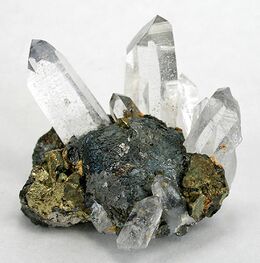Chemistry:Stannite
| Stannite | |
|---|---|
 | |
| General | |
| Category | Sulfide mineral |
| Formula (repeating unit) | Cu2FeSnS4 |
| Strunz classification | 2.CB.15a |
| Crystal system | Tetragonal |
| Crystal class | Scalenohedral (42m) H-M symbol: (4 2m) |
| Space group | I42m |
| Unit cell | a = 5.4432, c = 10.7299 [Å]; Z = 2 |
| Identification | |
| Color | Steel-gray to iron-black, may tarnish blue |
| Crystal habit | Rarely as pseudo-octahedral crystals also massive, granular, and disseminated |
| Twinning | Penetration twins on {102} |
| Cleavage | Indistinct on {110} and {001} |
| Fracture | Uneven |
| Mohs scale hardness | 4 |
| |re|er}} | Metallic |
| Streak | Black |
| Diaphaneity | Opaque |
| Specific gravity | 4.3 – 4.5 |
| References | [1][2][3] |
Stannite is a mineral, a sulfide of copper, iron, and tin, in the category of thiostannates.
Background
The chemical formula Cu2FeSnS4. Zinc commonly occurs with the iron and trace germanium may be present.[3] Stannite is used as an ore of tin, consisting of approximately 28% tin, 13% iron, 30% copper, 30% sulfur by mass. It is found in tin-bearing, hydrothermal vein deposits occurring with chalcopyrite, sphalerite, tetrahedrite, arsenopyrite, pyrite, cassiterite, and wolframite.[1]
It is also known as bell metal ore as tin is an important constituent of bell-metal. It is thought the exploitation of tin deposits in Cornwall led to an expansion in bell founding.
The name comes from the Latin for tin: stannum. It was first described in 1797 for an occurrence in Wheal Rock, St. Agnes, Cornwall, England .[3]
See also
References
- ↑ 1.0 1.1 "Stannite". http://rruff.geo.arizona.edu/doclib/hom/stannite.pdf.
- ↑ "Stannite". http://webmineral.com/data/Stannite.shtml.
- ↑ 3.0 3.1 3.2 "Stannite". http://www.mindat.org/min-3747.html.
- ↑ Warr, L.N. (2021). "IMA–CNMNC approved mineral symbols". Mineralogical Magazine 85 (3): 291–320. doi:10.1180/mgm.2021.43. https://www.cambridge.org/core/journals/mineralogical-magazine/article/imacnmnc-approved-mineral-symbols/62311F45ED37831D78603C6E6B25EE0A.
 |

